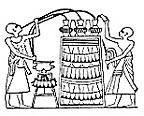
of the Roman aqueduct supplying Nimes.
On the CBS TV show Survivor, one of the first tasks the Survivors undertake is to locate their water source. Their next concern usually is sanitizing the water from the source so it is safe to drink. The Survivors search for the clearest looking water and then boil it over an open fire.
This basic form of water treatment saves the group from potential illness further down the line. Freedom from sickness really sums up the search for advancements in water treatment over the centuries.
Time has shown that strained water doesn't mean it's free of bacteria and odorless water doesn't necessarily mean it's safe to drink. How do we know this? Water treatment developed from years of experimenting, lessons of the past and the creation of new technologies.
Water treatment probably began with the first settlement of people. As long as prehistoric man was nomadic, contaminated water didn't have to be a concern. If the water supply for some reason went bad, the tribe could just move on. But as civilizations began to take shape, so did water treatment.

The Beginning
From what research has shown, the first recorded water treatment began with the Egyptians. Written around 2000 B.C., the Sus'ruta Samhita, Sanskrit writings about medical concerns, contained text telling readers that impure water should be boiled over a fire, heated in the sun, have a hot iron dipped into it or purified by filtration through sand and course gravel and then allowed to cool.Skipping to 13th and 15th centuries B.C., paintings of the first known sedimentation apparatus and wick siphons appear in tombs of ancient Egyptian rulers. From these paintings, researchers believe Egyptians might have used alum to remove suspended solids.
Elsewhere in the world among civilizations all prior to 500 B.C., Mayans developed multifaceted hydraulic systems for water distribution. More than 4,000 years ago, the ancient Hindu's directed people to heat foul water by boiling and exposing to sunlight and by dipping a piece of hot copper into it seven times, filtering it and then cooling it in an earthen vessel.

500 B.C. to 500 A.D.
Here enters the Greek physician Hippocrates, better known for his oath than his advancements in water treatment. Hippocrates wrote that water contributes much to health, but he focused more on selecting the healthiest water source, which was the clearest, rather than purifying less clear water sources.In his quest of the clearest water source, Hippocrates did invent the Hippocrates Sleeve, which consisted of a cloth bag, usually flannel or linen, sewn into a cone. This apparatus was used then to strain rainwater.
In neighboring Rome, engineers created a water supply system that delivered 130 million gallons daily through aqueducts between 343 B.C. to 225 A.D. The Romans' aqueduct system to bring clean water from far away is a good example of transporting uncontaminated water to cities. Other than the incidental disinfection effect of sunlight on water in open aqueducts, no water treatment was provided though.
Public water supply systems developed at the end of the third century B.C. in Rome, Greece, Carthage and Egypt. Storage or settling cisterns were constructed to remove silt by plain sedimentation. In this same area of the world, experiments began on controlling the taste and odor of these civilizations' water supplies. In the first century B.C., Diophanes recommended putting macerated laurel into rainwater. In the first century A.D., Paxamus suggested immersing bruised coral or pounded barley in a bag in bad tasting water.
500 to 1500
In 476 A.D., warriors attacked the city of Rome and pretty much any advancements in water treatment for the next 1,000 years ceased. These years usually are called the "Dark Ages" because learning and progression stopped in Europe and probably because that's how their water looked.But just because Europe didn't have anything going for it didn't stop advancement in Asia. In the eighth century A.D., Arabian alchemist Geber distilled water using wick siphons to purify it in the process removing "spirits." In the 11th century, a Persian physician named Avicenna recommended that travelers strain water through a cloth or boil it.
It also would be important to point out during this period of time, sicknesses and plagues spread by fleas, mosquitoes, excrement, filth and - most importantly - stagnant and contaminated water wreaked havoc of the population. It would be another 300 years before anyone linked the spread of disease with contaminated water.

1600s
Just when it looked like water treatment was going nowhere fast, Sir Francis Bacon, the Elizabethan philosopher, in 1627 recorded the only 10 experiments in the preceding 1,000 years, which related to water treatment. In his book, "A Natural History of Ten Centuries," experiments included water purification methods such as percolation, filtration, boiling, distillation and coagulation.In 1684, Dutch naturalist Antony van Leeuwenhoek made another great step forward by inventing the simple microscope. Leeuwenhoek drew pictures of the bacteria he viewed, opening a key to the connection between water and disease.
The first illustration of sand filters also came about in the 1600s. The Italian physician Lucas Antonius Portius published the details of a multiple sand filtration method in 1685. Portius described three pairs of sand filters - each pair consisting of a downward-flow filter and an upward-flow filter.
Water entered the system's settling compartment through a perforated plate that strained the water. Once the water had settled, it flowed from the top of the compartment through two funnels and down through the first filter. It then moved out through oblong openings in the bottom of the second filter and up through the second filter. The water continued in this same general pattern through the other two sets of filters.
1700s
During this century, filtered water became available in more homes. In 1703, Parisian scientist Phillippe La Hire proposed that every household have a sand filter and rainwater cistern. La Hire also documented that ground water rarely was contaminated.
In 1746, a fellow Frenchman Joseph Army was granted the first patent for a filter design. The filters consisted primarily of sponges and sand in a variety of configurations. Toward the end of the century, filtered water was sold on a small scale, but no large commercial plants were built. Also, British architect James Peacock patented a three-tank, upward-flow backwash filter in 1791.

1800s
In 1804, just more than 100 years after La Hire recommended that every house have a filtration system, Paisley, Scotland, became the first town with a filter facility that could deliver water to its entire population. The treatment plant consisted of concentric sand and gravel filters. Its distribution system only consisted of a horse and cart though.Two years later, a water treatment plant opened in Paris using the Seine River as a source. Water settled for 12 hours prior to filtration then ran through sponge prefilters that were renewed every hour. The main filters consisted of coarse river sand, clean sand, pounded charcoal and clean Fountainebleau sand. The filters were renewed every six hours. A simple form of aeration also was part of the process and horses, working in three shifts, drove the pumps. This plant operated for 50 years.
A year later in Glasgow, Scotland, the town's treatment plant piped filtered water directly to customers. By 1827, slow sand filters, designed by Robert Thom, were used in Greenock, Scotland. Similar systems designed by James Simpson were used in London in 1829. Simpson's design requiring scrapping became the English model throughout the world.
The first slow sand filtration plant in the United States started in Richmond, Va., in 1832. By 1833, the plant had 295 water subscribers. The next U.S. plant to open was in Elizabeth, N.J., in 1855. Slow sand filters were introduced in Massachusetts in the mid-1870s.
In the mid-1800s, London town officials noticed a decrease in cholera deaths where slow sand filters had been installed. After London officials realized contaminated water had been the culprit in these disease outbreaks, London enacted the Metropolitan Water Act of 1852, which required the filtration of all water supplied to the London area. This legislation is one of the first instances of government regulation of a water supply.
Also in this century, the first link between contaminated water and disease became clear. Evidence came in 1854 when John Snow was able to trace multiple cholera deaths to a single pump in Soho, England, which had become contaminated by a nearby leaking sewer. The users of this Broad Street well pump came from other parts of the town because they preferred the taste of the water. This is some of the first evidence that taste and clarity always do not indicate safe water.
Snow actually made the discovery of the cholera outbreak being linked to contaminated drinking water 16 years earlier, but he was ignored by the medical profession. No sanitary reform followed, which allowed the second cholera epidemic to follow where Snow made the Broad Street discovery. Snow basically was criticized because he couldn't identify what was in the water that was causing the epidemic.
In the 1870s, Robert Koch, the German physician and microbiologist, who created the "germ theory of disease," and Scottish surgeon Joseph Lister solved this problem by proving that microorganisms existing is water sources can cause disease. Koch made the actual discovery of the bacteria that causes cholera in 1876. Specifically in 1884, Koch isolated Vibrio cholera from the polluted Elbe River in Germany.
Since the isolation of certain bacteria in water, the United States has relied on several processes of water treatment to ensure the best water. Slow sand filtration soon proved to take too much time, space and labor. Because the need for clean water increased, rapid sand filtration was developed in the United States in the 1880s. During this time chlorine and ozone also were used for disinfection.
Up until the late 1860s, only 136 waterworks operated in the United States. Many didn't deliver filtered water. In 1881, William Stripe, superintendent of waterworks at Keokuk, Iowa, issued an invitation to all persons concerned with waterworks design, construction, operation, maintenance and management to gather at Washington University in St. Louis. The 22 respondents exchanged information pertaining to the management of water works and founded the American Water Works Association.
By the 1890s, filtration gained recognition for not only straining out undesirable particles, but also removing deadly germs. Towns along the Hudson River in New York that used filtration for water purification had fewer outbreaks and incidences of typhoid than communities that did not filter the Hudson River water. In the mid-1890s, the Louisville (Ky.) Water Co. combined coagulation with rapid sand filtration, reducing both turbidity and bacteria in the water.
At an 1894 meeting of the American Public Health Association, waterworks engineer George Warren Fuller suggested a cooperative effort toward standardization of bacteriological testing so that results from different laboratories could be compared. The result came in the form of an 1897 report that evolved into the Standard Methods text used today.

1900s
The age of chemical treatment found its place in the 20th century. In 1906, ozone made an appearance as a disinfectant in Nice, France. In the early 1900s, ozonation for disinfection became common in Europe, but was less prevalent in the United States. Ozonation equipment was more complex and costly than that used for chlorination, but ozone caused fewer taste and odor problems. Many Europeans also were reluctant to use chlorine after World War I, because it had been used as a chemical warfare agent.The next chemical to make an appearance in the U.S. was in 1908. The Jersey City (N.J.) Water Works became the first utility in the United States to use sodium hypochlorite for primary disinfection. That same year, the Bubbly Creek plant in Chicago instituted regular chlorine disinfection. Numbers of typhoid cases often plummeted following introduction of chlorine in towns.
In 1914, the U.S. Department of the Treasury promulgated the country's first drinking water bacteriological standard, a maximum level of two coliforms per 100 milliliters. By the 1920s, the use of filtration and chlorination had virtually eliminated epidemics of major waterborne diseases. This decade and the next saw the development of dissolved air flotation, early membrane filters, floc blanket sedimentation and the solids-contact clarifier. In 1925, the U.S. bacteriological standard was revised to one coliform per 100 milliliters and standards for lead, copper, zinc and excessive soluble mineral substances were added.
A major step in the development of desalination technologies came in the 1940s during World War II when various military establishments in arid areas needed water to supply their troops. In 1942, the U.S. Public Health Service created a set of drinking water standards that included bacteriological sampling in the distribution system and maximum permissible concentrations for lead, fluoride, arsenic and selenium. Hexavalent chromium was added to this list in 1946 and the membrane filter process for bacteriological analysis was approved in 1957.
By the early 1960s, more than 19,000 municipal water systems were in operation throughout the U.S. Most of these facilities used chlorine for disinfection. Although ozone was in common use in continental Europe throughout the 20th century, by 1980 only five American water treatment facilities were using it, primarily for taste and odor control or trihalomethane precursor removal.
Not until 1974, when the Safe Drinking Water Act (SDWA) was established, did the government, the public health community and water utilities throughout the country work together to safeguard the drinking water supply and to ensure that law protects public health in the best ways possible. The SDWA came about because of concerns over organic contaminants, and the law laid out the process the U.S. Environmental Protection Agency would use to set health-based maximum contaminant levels (MCLs) and the aesthetic-related secondary MCLs.
Although the EPA regulations in the 1980s focused on the minimization of disinfection by-products, concern for both chemical and microbial contaminants dominated the water industry in the 1990s. The 1993 Cryptosporidium outbreak in Milwaukee served as a reminder that another pathogen always exists that may cause acute health effects if an breakdown in treatment occurs.
2000
The Centers for Disease Control and Prevention and the National Academy of Engineering named water treatment as one of the most significant public health advancements of the 20th century. Advances in water supply and treatment ranked number four on the list - ahead of computers, telephones and nuclear technology.The number of treatment techniques, and combinations of techniques, developed is expected to increase with time as more complex contaminants are discovered and regulated. Many of the treatment techniques used today for cleaner drinking water include methods that have been used for hundreds and even thousands of years. It's the newer treatment methods that have yet to be utilized or discovered and mixed with the old methods that will bring the safer drinking water of tomorrow.


Report Abusive Comment